Potential in MRI and PET-CT Lymphoma Cancer Characterization
|
By MedImaging International staff writers Posted on 01 Apr 2013 |
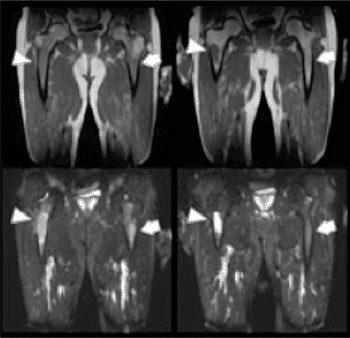
Image: T1- and T2-weighted MR images of focal lesions before and after systemic treatment (Photo courtesy of Dr. Jens Hillengass, German Cancer Research Center in Heidelberg, Germany).
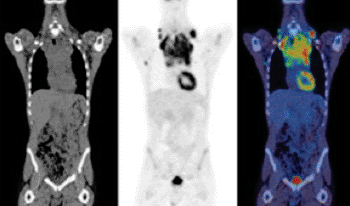
Image: Pre-treatment image of a patient with uptake in a mediastinal mass (Photo courtesy of Dr. Sally Barrington, London’s St. Thomas’ PET Imaging Center, UK).
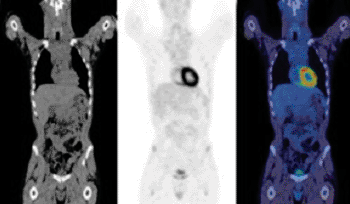
Image: Complete metabolic response on interim PET scan (Photo courtesy of Dr. Sally Barrington, London’s St. Thomas’ PET Imaging Center, UK).
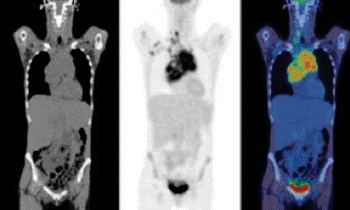
Images: Pre-treatment image of a patient with uptake in a mediastinal mass (Photo courtesy of Dr. Sally Barrington, London’s St. Thomas’ PET Imaging Center, UK).
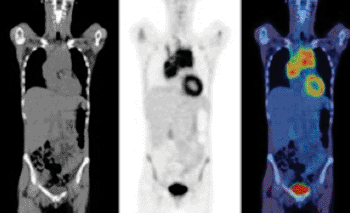
Image: High-grade uptake on interim PET scan indicating chemoresistance (Photo courtesy of Dr. Sally Barrington, London’s St. Thomas’ PET Imaging Center, UK).
Utilizing magnetic resonance imaging (MRI) in disease evaluation and positron emission computed tomography-computed tomography (PET-CT) imaging in therapy response assessment could optimize patient outcome in lymphoma cancer.
“MRI gives us more information and is probably the most important imaging technique in assessing disease activity in myeloma,” said Dr. Jens Hillengass, a physician scientist from the German Cancer Research Center (Heidelberg, Germany) who presented his findings on March 9, 2013, during the State of the Art symposium at the European Congress of Radiology (ECR), held in Vienna (Austria).
Current guidelines for the evaluation of therapy response are chiefly based on serologic markers and reference imaging to track large soft-tissue tumors. However, Dr. Hillengass thinks that imaging, and in particular MRI and PET, should be included in the recommendations, at least in some patients. For instance, many myeloma patients show changes on MRI that are not visible on a skeletal survey. MRI helps to differentiate between bone and bone marrow; it also has higher sensitivity for imaging of bone marrow effects in total, and demonstrates the first infiltration of plasma cells before overstimulation of osteoclasts and the resulting bone destruction.
Recent research indicates that some patients show diffuse infiltration of bone marrow with malignant plasma cells while others show focal infiltration. Several studies have looked at the prognostic significance of findings from MRI and PET, and suggest that a higher number of focal lesions are associated with a worse prognosis, Dr. Hillengass explained. His research group found that if focal lesions in bone marrow disappear upon MRI, then the patient outcome is better than if remission is defined according to serological markers. Being able to show that lesions are still there could help indicate relapse, which is the case for most patients.
If additional indications suggest that MRI can be used to evaluate disease activity and the extent of bone marrow infiltration with plasma cells prior to bone destruction, there might be a stronger case for earlier treatment, before bone destruction has started, Dr. Hillengass believes. “There are good data to say that if lesions persist, then treatment should continue; these data are on high-risk disease based on cytogenetics, and suggest treating patients for a long time is beneficial,” he said.
Interim PET could be used to monitor response-adapted therapy in Hodgkin lymphoma and aggressive non-Hodgkin lymphoma, according to Dr. Sally Barrington, a consultant physician in nuclear medicine at London’s St. Thomas’ PET Imaging Center (UK), who also spoke during the symposium.
PET was added to new response criteria for lymphoma in 2007 for assessment of the end of treatment response. Adding PET to CT response criteria improved the accuracy of measurement of treatment response after chemotherapy, but earlier assessment of response is needed during the course of therapy to improve patient outcome, she explained. “After only one to two cycles of chemotherapy, interim PET can accurately predict response by monitoring the reduction in FDG [fluorodeoxyglucose] uptake, even before there is a change in tumor size,” said Dr. Barrington, who made her point by presenting the five-point scale (5-PS), also called the Deauville criteria, which has been used in trials to score response on early PET scans.
Related Links:
German Cancer Research Center
“MRI gives us more information and is probably the most important imaging technique in assessing disease activity in myeloma,” said Dr. Jens Hillengass, a physician scientist from the German Cancer Research Center (Heidelberg, Germany) who presented his findings on March 9, 2013, during the State of the Art symposium at the European Congress of Radiology (ECR), held in Vienna (Austria).
Current guidelines for the evaluation of therapy response are chiefly based on serologic markers and reference imaging to track large soft-tissue tumors. However, Dr. Hillengass thinks that imaging, and in particular MRI and PET, should be included in the recommendations, at least in some patients. For instance, many myeloma patients show changes on MRI that are not visible on a skeletal survey. MRI helps to differentiate between bone and bone marrow; it also has higher sensitivity for imaging of bone marrow effects in total, and demonstrates the first infiltration of plasma cells before overstimulation of osteoclasts and the resulting bone destruction.
Recent research indicates that some patients show diffuse infiltration of bone marrow with malignant plasma cells while others show focal infiltration. Several studies have looked at the prognostic significance of findings from MRI and PET, and suggest that a higher number of focal lesions are associated with a worse prognosis, Dr. Hillengass explained. His research group found that if focal lesions in bone marrow disappear upon MRI, then the patient outcome is better than if remission is defined according to serological markers. Being able to show that lesions are still there could help indicate relapse, which is the case for most patients.
If additional indications suggest that MRI can be used to evaluate disease activity and the extent of bone marrow infiltration with plasma cells prior to bone destruction, there might be a stronger case for earlier treatment, before bone destruction has started, Dr. Hillengass believes. “There are good data to say that if lesions persist, then treatment should continue; these data are on high-risk disease based on cytogenetics, and suggest treating patients for a long time is beneficial,” he said.
Interim PET could be used to monitor response-adapted therapy in Hodgkin lymphoma and aggressive non-Hodgkin lymphoma, according to Dr. Sally Barrington, a consultant physician in nuclear medicine at London’s St. Thomas’ PET Imaging Center (UK), who also spoke during the symposium.
PET was added to new response criteria for lymphoma in 2007 for assessment of the end of treatment response. Adding PET to CT response criteria improved the accuracy of measurement of treatment response after chemotherapy, but earlier assessment of response is needed during the course of therapy to improve patient outcome, she explained. “After only one to two cycles of chemotherapy, interim PET can accurately predict response by monitoring the reduction in FDG [fluorodeoxyglucose] uptake, even before there is a change in tumor size,” said Dr. Barrington, who made her point by presenting the five-point scale (5-PS), also called the Deauville criteria, which has been used in trials to score response on early PET scans.
Related Links:
German Cancer Research Center
Latest Nuclear Medicine News
- Novel Radiolabeled Antibody Improves Diagnosis and Treatment of Solid Tumors
- Novel PET Imaging Approach Offers Never-Before-Seen View of Neuroinflammation
- Novel Radiotracer Identifies Biomarker for Triple-Negative Breast Cancer
- Innovative PET Imaging Technique to Help Diagnose Neurodegeneration
- New Molecular Imaging Test to Improve Lung Cancer Diagnosis
- Novel PET Technique Visualizes Spinal Cord Injuries to Predict Recovery
- Next-Gen Tau Radiotracers Outperform FDA-Approved Imaging Agents in Detecting Alzheimer’s
- Breakthrough Method Detects Inflammation in Body Using PET Imaging
- Advanced Imaging Reveals Hidden Metastases in High-Risk Prostate Cancer Patients
- Combining Advanced Imaging Technologies Offers Breakthrough in Glioblastoma Treatment
- New Molecular Imaging Agent Accurately Identifies Crucial Cancer Biomarker
- New Scans Light Up Aggressive Tumors for Better Treatment
- AI Stroke Brain Scan Readings Twice as Accurate as Current Method
- AI Analysis of PET/CT Images Predicts Side Effects of Immunotherapy in Lung Cancer
- New Imaging Agent to Drive Step-Change for Brain Cancer Imaging
- Portable PET Scanner to Detect Earliest Stages of Alzheimer’s Disease
Channels
Radiography
view channel
AI Improves Early Detection of Interval Breast Cancers
Interval breast cancers, which occur between routine screenings, are easier to treat when detected earlier. Early detection can reduce the need for aggressive treatments and improve the chances of better outcomes.... Read more
World's Largest Class Single Crystal Diamond Radiation Detector Opens New Possibilities for Diagnostic Imaging
Diamonds possess ideal physical properties for radiation detection, such as exceptional thermal and chemical stability along with a quick response time. Made of carbon with an atomic number of six, diamonds... Read moreUltrasound
view channel.jpeg)
AI-Powered Lung Ultrasound Outperforms Human Experts in Tuberculosis Diagnosis
Despite global declines in tuberculosis (TB) rates in previous years, the incidence of TB rose by 4.6% from 2020 to 2023. Early screening and rapid diagnosis are essential elements of the World Health... Read more
AI Identifies Heart Valve Disease from Common Imaging Test
Tricuspid regurgitation is a condition where the heart's tricuspid valve does not close completely during contraction, leading to backward blood flow, which can result in heart failure. A new artificial... Read moreNuclear Medicine
view channel
Novel Radiolabeled Antibody Improves Diagnosis and Treatment of Solid Tumors
Interleukin-13 receptor α-2 (IL13Rα2) is a cell surface receptor commonly found in solid tumors such as glioblastoma, melanoma, and breast cancer. It is minimally expressed in normal tissues, making it... Read more
Novel PET Imaging Approach Offers Never-Before-Seen View of Neuroinflammation
COX-2, an enzyme that plays a key role in brain inflammation, can be significantly upregulated by inflammatory stimuli and neuroexcitation. Researchers suggest that COX-2 density in the brain could serve... Read moreGeneral/Advanced Imaging
view channel
AI-Based CT Scan Analysis Predicts Early-Stage Kidney Damage Due to Cancer Treatments
Radioligand therapy, a form of targeted nuclear medicine, has recently gained attention for its potential in treating specific types of tumors. However, one of the potential side effects of this therapy... Read more
CT-Based Deep Learning-Driven Tool to Enhance Liver Cancer Diagnosis
Medical imaging, such as computed tomography (CT) scans, plays a crucial role in oncology, offering essential data for cancer detection, treatment planning, and monitoring of response to therapies.... Read moreImaging IT
view channel
New Google Cloud Medical Imaging Suite Makes Imaging Healthcare Data More Accessible
Medical imaging is a critical tool used to diagnose patients, and there are billions of medical images scanned globally each year. Imaging data accounts for about 90% of all healthcare data1 and, until... Read more
Global AI in Medical Diagnostics Market to Be Driven by Demand for Image Recognition in Radiology
The global artificial intelligence (AI) in medical diagnostics market is expanding with early disease detection being one of its key applications and image recognition becoming a compelling consumer proposition... Read moreIndustry News
view channel
GE HealthCare and NVIDIA Collaboration to Reimagine Diagnostic Imaging
GE HealthCare (Chicago, IL, USA) has entered into a collaboration with NVIDIA (Santa Clara, CA, USA), expanding the existing relationship between the two companies to focus on pioneering innovation in... Read more
Patient-Specific 3D-Printed Phantoms Transform CT Imaging
New research has highlighted how anatomically precise, patient-specific 3D-printed phantoms are proving to be scalable, cost-effective, and efficient tools in the development of new CT scan algorithms... Read more
Siemens and Sectra Collaborate on Enhancing Radiology Workflows
Siemens Healthineers (Forchheim, Germany) and Sectra (Linköping, Sweden) have entered into a collaboration aimed at enhancing radiologists' diagnostic capabilities and, in turn, improving patient care... Read more





















